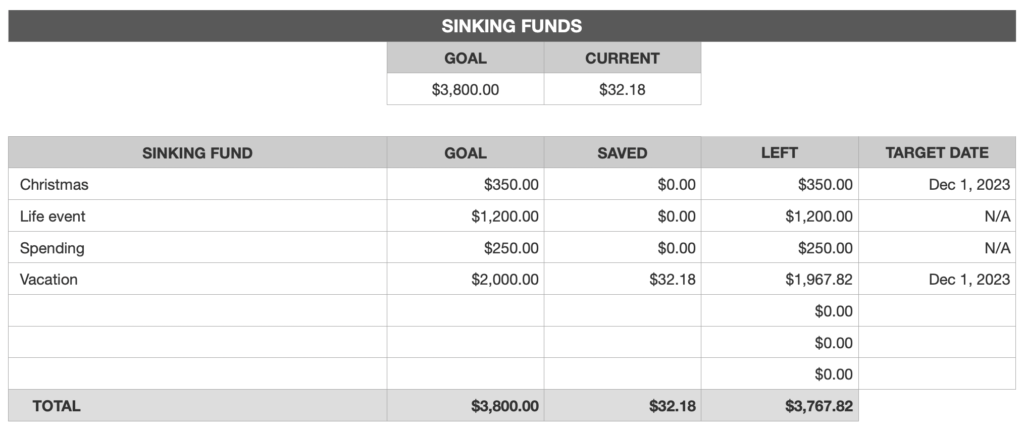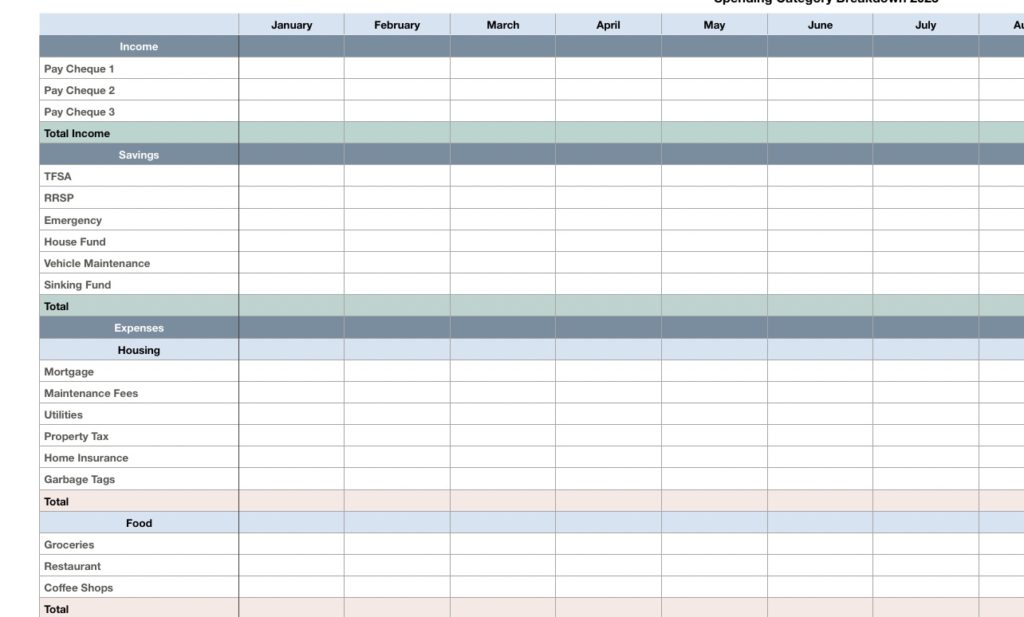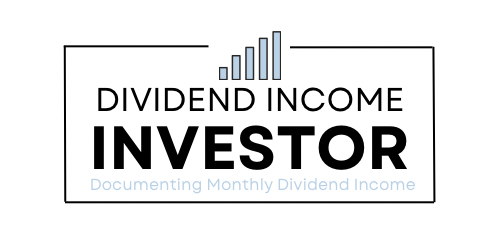Financial goals for 2023 — 9 Personal finance and dividend income investing goals for the new year. This post contains one affiliate link to investment brokerage. I am not a licensed investment advisor and this post is not financial advice. All opinions are my own.
I have been writing out my financial goals for the new year on this blog since 2017.
Over this span of time, I have managed to grow my dividend income to $1350.22 annually and acquire a property. I truly believe that yearly goal setting has helped me achieve these accomplishments.
As such, I am writing out my financial goals for the new year again on this blog. Since I’ve found financial goal-setting to be so effective, I would encourage everyone to set financial goals of their own each year. Just remember to make sure they are clear, measurable, and achievable goals. They have to be realistic.
In this post, I will discuss my specific financial goals for 2023.
Let’s dive in.
Financial Goals For 2023 Theme
My long-term financial goal is to become financially independent through dividend income investing. So my financial goals will always be centred around that ambition.
But each year has its own set of short-to-medium term goals. For example, my priority last year was to purchase a condo or a house. Fortunately, I was able to accomplish that goal and transition from renter to home owner.
Now that the home ownership goal is out of the way, my focus has shifted back to dividend investing. However, home ownership has come with its own share of additional expenses and responsibilities.
In turn, the theme for my financial goals for 2023 is financial organization.
In short, I need to be more financially organized than ever to stay on top of my bills, budget accordingly, and continue to save to eventually become financially independent through dividend investing.
Without further ado, here are my financial goals for 2023.
Financial Goals For 2023
1. Earn $1,400 In Dividend Income (3.7% Growth)
My main challenge for 2023 is to earn at least $1,400 in dividend income.
Of course, this would only be a modest increase compared to the $1,350.22 I received in 2022.
Based on the same 65% growth rate achieved in 2022, I should be aiming for $2,227 plus. However, I ended up selling a few of my positions in order to buy a property. As a result, my projected dividend income is lower to start off the year.
But I am hoping that the combination of dividend raises, reinvesting dividend income, and adding capital through savings will lead to at least $1,400 annually.
I will consider it a success if I can beat the $1,350.22 I received in 2022.
To get there, I will need to add around $10,000 to my portfolio in 2023. This shouldn’t be a problem. However, I need to save and invest that money before the ex dividend dates to receive the dividends.
Of course, dividends raises will add at least $75 over the year. Furthermore, reinvesting $1,000 worth of dividends will add another $50. So, I will be able to earn $1,400 in dividends even if I save enough to add $300 worth of dividend income.
Based on the $533.40 I added in 2022, I expect to make this happen.
I plan on continuing to publish monthly dividend income updates in 2023 to track my progress to $1,400.
2. Grow Forward Dividend Income To $1,600 Annually
By the end of 2023, my goal is to have a portfolio that generates at least $1,600 annually in dividends.
I can achieve this goal if I invest approximately $15,000 during the course of the year.
Similar to my dividend income target, my forward dividend income target is lower than it should be. At the high point in 2022, my portfolio was already projected to generate $1,529 annually. I would have easily hit $1,800 to $2,000 by the end of 2022 if I kept on renting.
However, selling stocks to purchase a property set my portfolio back a bit. As such, I am setting my sights on $1,600 in forward annual dividend income by the end of 2023.
By the time 2024 rolls around, I expect to get back to more consistent and predictable growth.
3. Pay Zero On Commission & Investment Expenses
I spent $198.50 on commission and investment expenses in 2022.
In 2023, however, my goal is to spend zero dollars on commission and investment expenses.
The way I plan on accomplishing this is by utilizing a zero commission brokerage TFSA, and through paying for commission with credit card reward points in my RRSP.
Otherwise, better financial organization will help me avoid any unexpected trades.
4. Earn $160 In One Month From Dividends
Another dividend-related goal for this year is to reach a new all-time high in one month. Of course, this is lower on my priority list. My main goal is to grow annual dividend income overall.
But it would still be nice to exceed last year’s all-time high of $152.18. I received this amount of dividends back in September 2022.
If I am able to hit a new all-time high for one month, it will likely happen in the September or December quarter.
5. Save 16% Minimum Of Net Income For Financial Independence/Retirement
At the very least, my savings goal for 2023 is to save a minimum of 16% of my net income for retirement.
Admittedly, this percentage should be a lot higher for someone who claims to be aiming for financial independence.
But keep in mind that this percentage is only my retirement savings. This is the amount goes towards my TFSA and RRSP. I am also being cautious because I’m not sure how this year will play out after purchasing a home and car in 2022. I typically exceed my savings goal by a lot. For instance, I aimed for 15% last year and ended up saving over 27%.
Ideally, I will end up overachieving again, as I’m already planning to save over 30% of my first pay cheque of the year.
6. Contribute At Least 1% Of Net Income Per Pay To Personal Emergency Fund
Aside from my retirement savings, I am aiming to build up my emergency fund after using most of it to buy a home in 2022.
Simply put, my goal is to consistently contribute at least 1% of my net income to my emergency fund from each pay.
Similar to my retirement savings, I am low balling this number to make sure I do not overextend myself. For example, I am planning to contribute 3% of my net income from my first pay of 2023.
This personal emergency fund will be separate from my retirement accounts and will be accessible in a savings account. I will only use this money if there is an actual emergency. I view my emergency fund as an insurance to protect my retirement savings.

7. Establish A Sinking Fund & Meet Savings Goals By End of 2023
In addition to retirement and emergency savings, I am setting up a sinking fund in 2023.
For those who are unfamiliar with the concept, a sinking fund is a strategic way to save for specific purchases by saving small amounts over time.
Essentially, I will save money from each pay and set it aside in a savings account. The savings account is separate from my emergency fund and retirement savings. Then I will create a spreadsheet to track how much of the savings belongs to each purchase I am saving for.
For example, my sinking fund has four separate categories: vacation, Christmas, personal spending, and life events.
Ideally, I will contribute at least 1% of my net income to each category throughout the year. Once the dollar amount of a category is achieved, I will funnel an additional percentage to the category that has not met its goal amount yet.
In truth, I only recently learned about sinking funds and immediately loved the idea. It’s almost like having an emergency fund for your emergency fund. And now all my spending will be planned. Originally, I was going to open up an account for each purchase. But a sinking fund allows me to save for different goals within one account.
The main purchase I want to save for in 2023 is a trip to Brazil in early 2024. My partner is from Brazil so a vacation there is long overdue. Unfortunately, I haven’t been able to visit yet because of my job hours, covid, and the home purchase. I am hopeful that my sinking fund will help me plan better for vacations going forward. Since a trip to Brazil is a high priority, I may direct the bulk of my sinking fund savings towards the trip this year.
Otherwise, the personal spending will be for when I want to purchase things like new tech, shoes, and clothes. I honestly don’t buy very much for myself so even a small amount will be more than enough.
The Christmas portion of my sinking fund is self-explanatory. It will be nice to get to December and have money available to spend.
And the life event portion of my sinking fund could be for a special occasion.
8. Fund A Joint Account For Housing Expenses & Vehicle Maintenance
In addition to my retirement accounts, emergency fund, and sinking fund, my partner and I have two joint accounts.
One of our joint accounts is a chequing account for our bill payments. For example, our mortgage payment, property taxes, and insurance payments come from this account.
Our other joint account is our home savings and vehicle maintenance account. Basically, it is an emergency fund for our house and vehicle. But it’s also a spending account that we use to pay for household items we want. Whenever it’s above a certain threshold, we are allowed to spend it on items we want for the house. If we see something we like at Homesense and the housing account is overfunded, we get to spend it.
To fund this account, I plan to contribute a minimum of 1% of each pay for housing and 1% for vehicle maintenance. We already have some funds remaining in the account that are left over from the downpayment and closing costs.

9. Maintain Budget & Remain Financially Organized On A Daily Basis
Although I usually refrain from mentioning less measurable financial goals, I am including this point on budgeting and financial organization.
Simply put, my goal is to track my budgeting, personal finance, net worth, and investing spreadsheets daily.
Over the past month or so, I’ve set up three main spreadsheets to extensively cover my personal finances. The three spreadsheets are the following: net worth, income investing business, and personal finance 2023.
The net worth spreadsheet tracks all assets and liabilities. The income investing business spreadsheet tracks total investment returns, dividend income, forward dividend income, capital gains, yield on cost, and more. Finally, the personal finance spreadsheet covers my bi-weekly budget, tracks and categorizes every expense, tracks savings, and it also includes my sinking fund.
Although it requires a lot of discipline and work to stay on top of all these spreadsheets, it’s easy for me because it’s more of a hobby. I love to analyze and track data.
I am looking forward to being the most financially organized I’ve ever been in 2023.

Financial Goals For 2023 — Final Thoughts
In summary, I am setting 9 financial goals for 2023 to improve my financial situation.
As always, my main financial goals are centred around my long-term ambition to become financially independent through dividend investing. If all goes to plan, I will earn at least $1,400 in dividends, grow forward dividend income to beyond $1,600 annually, pay zero in commission and investment fees, and hit a new all-time high for dividends received in one month.
If I follow through on my personal financial goals for 2023, at minimum, I will end up saving 23% of my net income. 16% will be put towards financial independence/retirement, 1% will go towards my emergency fund, 4% will go towards my sinking fund, and 2% will be put towards a housing and vehicle maintenance account.
Of course, these percentages are the minimum amounts I am aiming to save. I am hoping to fully fund my sinking fund and save a lot more than 16% for retirement.
But after a life-changing 2022 which included a home and vehicle purchase, I am attempting to remain cautious.
Related Personal Finance Posts To Check Out
Financial Goals For 2022 — 7 Momentous Personal Finance Goals
Year End Financial Review 2022
Dividend Income December 2022 — 65% YTD Growth
I am not a licensed investment or tax adviser. All opinions are my own. This post may contain advertisements by Monumetric and Google Adsense. This post may also contains internal links, affiliate links to BizBudding, Amazon, Bluehost, and Questrade, links to trusted external sites, and links to RTC social media accounts.
Connect with RTC
Twitter: @Reversethecrush
Pinterest: @reversethecrushblog
Instagram: @reversethecrush_
Facebook: @reversethecrushblog


 Year End Financial Review 2022
Year End Financial Review 2022
